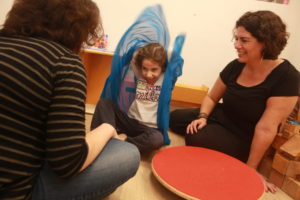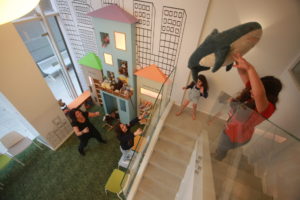General description :
Affective container is a therapeutic method in the Neuro-Geometric Approach in which the parent or therapist guides the general emotional tone in the room. Affective tone facilitation is used to create an environment that reduces anxiety and increases bonding and synchronization in parent-child interaction. The affective container focuses on stimulating the levels of sensory regulation in the interactive partners in the room. Participants can use different affective tools to increase or decrease the sensory regulation in the relationship and hence the environment they share (the container), such as with a playful and rhythmic voice, as opposed to a slower and more soothing voice (Vig, A. 2019).

When is it suitable?:
When the child is outside their optimal regulation zone – too much or too little sensory-processing, or when the parent and child have difficulty producing sensory input tailored to the child’s needs in the interaction between them, in which case the affective facilitator intervenes to produce the adjusted “affective container.”
Objectives:
-
- 1. Assist the child in regulating by the assistance of the parent/therapist
- 2. Create an effective (emotional) environment that lowers or raises the level of sensory regulation
- 3. Help the child to make a positive connection by way of others
Tools:
Affective tools include playfulness, dramatization, vocals, etc. Initial stages should be centered on object-free play. )

Guidelines
- 1. Increase playfulness, excited tones and dramatization when the child is under-stimulated to attract him to engage in situations of drowsiness, disengagement, or staring.
- 2. Decrease the pace, sharpness of tone, and verbal input when the child is overstimulated as sometimes manifests in repetitive, excited motions, rapid movement between objects, or motoric restlessness.
- 3. It is recommended to limit the use of objects. Facilitators should use only sensory-engaging objects such as a physioball, long soft cloth, and the like.
- 4. Use of regular rhythms – fast or slow depending on the child’s needs.
- 5. Use of voice
- 6. Slow transitions suited to the child’s needs.
Key Points
- ● Monitor the child’s regulation level
- ● Adjust the interaction with the child’s level of sensory regulation in the space – raise sensory input and lower anxiety-triggers to create a more meaningful connection.
Examples:
Example 1: Increasing the level of sensory input
A child lies on the beanbag and stares at the light. The therapist leads the mother in fun games with the child to present her in the relationship by accompanying the games with stimulating sounds (to increase sensory processing). Following this, the mother moves away a bit, and the child sits down to try and reach her (“Oh oh oh, he’s not coming” in a playful voice). To continue the engagement, the therapist guides the mother to move away from the child and begin a fun game of tag, calling out “run, run, run” playfully and calmly. Increasing the sensory input in the room allows the child to create a line of quality interaction with his mother.
Example 2: Lowering sensory input
A child runs around the room, not noticing her mother calling her name. The therapist instructs the mother to approach the child, to crouch to the height of the child, hold her shoulders firmly and slowly get closer to hug her tightly, accompanied by the therapist’s verbalizations –
“‘ A.’ wants a good hug… a nice, warm hug .. ” in a slow, low voice.
Example 3: The Educational Setting
The teacher sees that the class is “dormant,” and sensory engagement is low. The teacher will use a more dramatic voice to engage the children and incorporate movement activities. In another case, when the class is buzzing and difficult to control, the teacher will take the children out for a game of walking in circles one after the other like a train, at varying rhythms, and gradually slowing down. The synchronization and pace dictated will allow students’ sensory regulation to decrease or increase as needed.